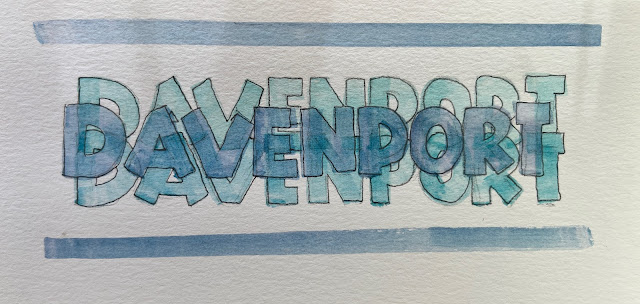 |
| It doesn't feel like fall yet in San Francisco. |
Davenport. When was the last time you heard someone refer to a couch or sofa as a Davenport? The name originally came from Cheshire, England, and was used by a furniture manufacturing family in New England for their expensive, fancy settees, divans, chaise longues, or chesterfields. Maybe if you came from that area back East, you are more familiar with the word Davenport. Recently I have only heard Davenport as a name for a place or person, not something to lounge on.
I received an email inviting me to the International Calligraphy Conference next summer which will take place in Davenport, Iowa. I was curious why that town in the middle of the country in the middle of summer had been selected. I was curious about the name Davenport too. I remembered hearing it used in my childhood, but rarely since. I discovered the conference was dedicated to the work of Father Edward Catich, a monk from St. Ambrose University, who wrote a book entitled The Origin of the Serif (only a calligrapher would write a book on a small mark which has major significance in letter design. Amazon offers the paperback version of this book for $130 -- a collector's item, for sure.) But I digress from the word Davenport. Last night as we sat down to watch the first episode of the original Miss Marple series on PBS, I smiled when I saw the name of one of the leads, Jack Davenport, an English actor. I also discovered that there are twelve towns in the United States called Davenport. There is a lake in Minnesota and also a mountain peak in New Mexico with the name. The first Davenport to arrive in the U.S. was Lancelot Davenport. Now that's a name to remember. Davenport seems to be everywhere I look.
 |
| Practicing more layered letters with Neuland font, which is sans-serif |
Recently as we drove along Highway 1 which hugs the Pacific Coast, we passed the town of Davenport, which calls itself Whale City. Davenport is only a couple of short blocks long and easy to drive by, but it is a good place to watch whales as they migrate through Monterey Bay. Nearby Shark Fin Beach offers plenty of places to explore, though because of the cliffs towering over the beach, checking tides before walking down the beach paths would be a good idea.
This morning I opened an email from the Commonwealth Club in San Francisco and found that Matthew Davenport, author of The Longest Minute, would be speaking about the 1906 San Francisco earthquake. Another Davenport!
 |
| Letter formed with serifs |
I mention these examples of a word that pops up repeatedly for a short time because I also find that true of themes in books that I read. For example, earlier in the year I finished Amor Towles' book, The Lincoln Highway, which takes place during the Great Depression. I also read The Personal Librarian by Marie Benedict and Victoria Christopher Murray, about the Black woman who was the original librarian for the J.P. Morgan Library, and The Book Woman of Troublesome Creek by Kim Michelle Richardson, both books are based during that time period. The era between the two world wars fascinates me because so many of our ideals and beliefs about America are reflected in the cultural, economic, and political events that occurred from the Great Influenza of 1918 to the beginning of World War II and they continue to echo in the present day.
I don't intentionally seek out books set in the time period between the two world wars, yet I just finished West With Giraffes by Lynda Reynolds, based on a true story of transporting two giraffes across the country. I picked West With Giraffes because a friend writes essays about rhinos in Africa, which has nothing to do with the subject of West With Giraffes except they are both about African animals and their interactions with human beings.
This theme of personal development during a long trip resonates with me. America the Beautiful? by Blythe Roberson tells about her venture alone into our National Parks and the unsettling history she discovers behind one of the best things about America. The Ride of Her Life by Elizabeth Letts, describes how Annie Wilkins rides a horse across the U.S. to reach the Pacific Coast and what she discovers about mid-century America.
My question here at the end: Why is it that when something is noticed, its appearance multiplies? I just got an email that Tim O'Brien, author of The Things They Carry, is out with a new book called, America Fantastica, and whether it is a good book or not (read the NYTimes review), it follows alongside a fictional character in search of himself by traveling across America.
Check out Davenport, California:
https://www.tripadvisor.com/Tourism-g32282-Davenport_California-Vacations.html
Check out the course offerings at the International Calligraphy Conference:
https://www.calligraphyconference.org
Tim O'Brien's latest book:
https://www.nytimes.com/2023/10/23/books/review/tim-obrien-america-fantastica.html
Interesting online magazine to read:
No comments:
Post a Comment
Thank you for commenting! I love hearing from readers. I answer each one.
I do not post Anonymous comments because of problems with spammers.